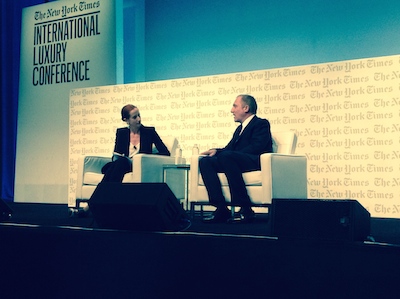 Gucci disco bag
Gucci disco bag
MIAMI – Technology and art are natural partners of luxury brands, but these partnerships are most effective when the parties stay true to themselves, said an executive from Kering at The New York Times International Luxury Conference Dec. 2.
Technology should help rather than hinder craftsmanship, and art and fashion need to hold onto their individual visions as they enter into partnerships. Most importantly, luxury needs to hold onto its branding as it partners with other entities.
“There is no question that art, technology and luxury can enrich each other very profitably," said François-Henri Pinault, CEO and chairman of Kering. "The three disciplines have been engaged in a dialogue for a long time.
"The boundaries are inherently porous and our job is to make sure that luxury remains true to itself," he said. "A business that thrives on emotions, on creativity, on quality and on functionality."
Artistic touch
The relationship between art and fashion is nothing new. Mr. Pinault mentioned the examples of Elsa Schiaparelli and Salvadore Dali teaming up for the lobster dress in the 1930s and Saint Laurent’s Mondrian-inspired dresses in the 1960s.
François-Henri Pinault with moderator Vanessa Friedman
According to Mr. Pinault, this is a “natural conversation,” since both types of creatives work in similar ways, looking everywhere for inspiration and both speak about the culture at a particular time. As time progresses, the lines are blurring more, as art emerges from the museum and galleries and fashion finds itself displayed in spaces typically occupied by art.
For instance, British fashion label Alexander McQueen will host the first European retrospective of its late eponymous designer’s work with an exhibit at London’s Victoria and Albert Museum.
Alexander McQueen look on display in "Savage Beauty"
“Alexander McQueen: Savage Beauty,” which was on display at the Metropolitan Museum of Art in New York in 2011, will open at the V&A in spring 2015, presented in partnership with Swarovski (see story).
Kering in particular often partners with cinema. Gucci has a longstanding relationship with film, which has been strengthened by its work with the Tribeca Film Institute and its partnership with Martin Scorsese’s film foundation to preserve film.
Recently, Kering announced a long-term partnership with the Cannes Film Festival. Mr. Pianult stressed that this partnership is more than just an awareness building effort tied to the red carpet. The conglomerate is using its position as a platform to talk about gender equality in film.
Film itself is a natural luxury partner.
“Like luxury, the cinema is a dream machine,” Mr. Pinault said.
Technology as a tool
Mr. Pinault stressed that for luxury, the use of technology is different from other industries. Rather than using technology to change the production process, it is more apt to be used to create new textiles to allow for more designer creativity.
Since the fashion calendar, with the need for new collections every few months, doesn’t allow time for brands to do their own research and development, Kering created a centralized material innovation lab. Here, expert research greener materials.
Technology also plays a part in Kering’s sustainability efforts, which are at the core of its business. The group has a commitment, which outlines goals the company has for 2016, including becoming completely PVC-free, getting all of its diamonds from verified sources and procuring its paper for packaging from recycled materials and sustainably managed forests. Kering will measure and analyze its environmental impact in 2016 and put a monetary value on it (see story).
Gucci's eyewear uses wood rather than plastic
Over the course of about three years, Gucci looked at the tanning process to find an alternative to the use of heavy metals, without lowering the quality of the leather.
Looking beyond its own group brands, Kering is making all of the findings about new, more sustainable production methods available to the public.
Kering has also tapped technology to assist with its distribution, shipment tracking and ecommerce programming. In stores, sales associates are armed with handheld devices to ease the shopping process.
In Gucci’s store in New York, QR codes can be scanned so the sales associate can immediately give customers product information.
Watches have traditionally been the exception, where technology is central to the product’s luxury status, and consumer desire for a particular timepiece.
Mr. Pinault said that luxury brands should embrace technology when one of these four factors is present: it strengthens the quality or the sustainability of the materials, offers new areas of expression, improves the quality of production processes or creates new functionalities.
Smart watches are one example of new functionalities not found in a watch previously. Mr. Pinault said that Kering is thinking about working with someone on a device, but is focused on creating something that heightens the exclusivity surrounding its watches, which are a piece of art themselves.
“We need to view technology with a critical eye," Mr. Pinault said.
"I think it’s easy to be mesmerized by new innovations," he said. "But in luxury, we should not jump on any buzz concept just for the sake of looking modern."
Final Take
Sarah Jones, editorial assistant on Luxury Daily, New York



